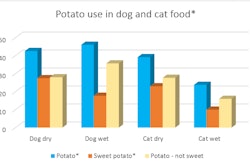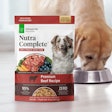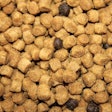
The dietary needs of dogs and cats are more complex than ever. Pet owners want pet food formulas uniquely designed to suit their companion animals, and formulators must continue to maintain the balance of giving pet parents what they want and ensuring the health and wellness of the animals they serve remain top priorities.
It is, then, no surprise that recent pet research is focused on pet diets, as well as the effects of those diets on animal health.
Breaking new ground: gastrointestinal health and macronutrients
One study, published online with the Journal of Animal Physiology and Animal Nutrition (JAPAN), takes a look at how dietary particle size may affect the gastrointestinal transit of dogs.
“The effect of dietary particle size on gastrointestinal transit in carnivores has not been studied and might offer more insight into their digestive physiology,” say the study’s authors. “How does dietary particle size affect carnivore gastrointestinal transit: A dog model” evaluated the effect of two dietary particle sizes (fine vs. coarse) of chunked day-old chicks on transit parameters in six Beagles. The dogs were fed both dietary treatments in a crossover design of seven days with transit testing on the fifth day, using two markers: a wireless motility capsule and titanium oxide.
According to the study, dietary particle size did not affect gastric emptying time, small bowel transit time, colonic transit time or total transit time. There was no effect of dietary particle size on titanium oxide mean retention time, though the time of last titanium oxide excretion (MaxRT) differed between diets, being later for the coarse diet. Both mean retention time and MaxRT were positively correlated to total transit time. The ratio of mean retention time/total transit time tended towards a difference between diets, with the coarse diet exceeding fine diet values.
Overall, “results show that the difference between capsule measurements and titanium oxide is larger for the fine than the coarse diet, suggesting that the capsule becomes more accurate when dietary particle size approaches marker size,” say the study’s authors. “Dietary particle size might have affected transit parameters, but differences are too small to claim major physiological consequences.”
Another JAPAN study breaking new ground is “Macronutrient intake of dogs, self-selecting diets varying in composition offered ad libitum,” also published online in October 2017. According to the study’s authors, at the time they began their research only two studies had been done examining macronutrient self-selection in dogs. The first focused solely on protein intake, while the second investigated dietary protein, fat and carbohydrates. “This study's aim was to further elucidate macronutrient intake by providing greater macronutrient range, energy content, and to investigate over a longer duration than previous studies,” say the authors.
Fifteen adult dogs were given access to three wet diets providing 500 percent of daily metabolizable energy, twice daily over 10 days. The diets were nutritionally complete and formulated using the same four ingredients in different proportions to supply high levels of protein, fat or carbohydrates. Overall fat and carbohydrate consumption significantly declined from 6,382 to 917 kcals per day and 553 to 214 kcals day, respectively. Protein intake remained constant over the study and ranged from 4,786 to 4,156 kcals day.
These results, according to the study, impacted on percentage total energy intake, with fat decreasing from 68 percent to 52 percent, and protein increasing from 29 percent to 44 percent. “Our findings suggest that dogs still possess a ‘feast or famine’ mentality, wherein energy-dense fat is prioritized over protein initially,” say the authors. “With continued feeding over 10 days, a transition to a more balanced energy contribution from both macronutrients is evident. The study also shows that given the option, dogs do not select carbohydrate to be a significant portion of the diet. The health implications of such dietary selection are of interest.”
Cat and dog health: taking a closer look
Consuming canned cat food can be considered a risk factor for the development of feline hyperthyroidism, and a study published online with JAPAN aimed to “determine whether increased dietary selenium or water alters the function of the hypothalamic-pituitary-thyroid axis and leads to an increase in activity level.”
The research, “Effects of dietary selenium and moisture on the physical activity and thyroid axis of cats,” studied six neutered male domestic shorthair cats. The cats were fed a commercially available adult dry feline diet with 0.8 ppm selenium (the control), added sodium selenite to increase the selenium concentration to 1.125 ppm (the selenium treatment), and added water to reach a moisture content of 75 percent wt/wt (the water treatment).
There was a significant increase in daily water consumption with the water treatment compared to the control and selenium treatments, and both water and selenium treatments were associated with greater activity over that of the control (by 20.5 percent and 11 percent, respectively). Serum concentrations of thyrotropin-releasing hormone stimulation tests were greater by 16 percent with water compared to control treatments.
According to the study’s results, dietary water content may alter the function of the thyroid axis, and this effect is associated with an increase in physical activity.
As pets live longer lives, old-age conditions are becoming more prevalent, and pet owners are looking to pet foods as a first line of defense against age-related ailments. One study, “Polyunsaturated fatty acids influence inflammatory markers in a cellular model for canine osteoarthritis,” was designed to “further clarify how polyunsaturated fatty acids affect key factors of cartilage degeneration in a canine cell culture system mimicking osteoarthritis,” according to the study’s authors.
Canine chondrocytes were incubated either without or with 10 μm of eicosapentaenoic acid (EPA), docosahexaenoic acid (DHA), arachidonic acid (AA) or 3.6 μm ibuprofen (Ibu) as a positive control for six days. After the supplementation, cells were stimulated with 10 ng/ml interleukin-1β (IL-1β) for another 48 hours to induce osteoarthritic changes, or left unstimulated.
The results revealed molecular mechanisms by which polyunsaturated fatty acids affect degenerative joint disease in dogs. Of particular importance, according to the study’s authors, is that both eicosapentaenoic acid and arachidonic acid decreased several inflammatory markers in the model. The researchers concluded that an appropriate balance of both n-3 and n-6 fatty acids deserves more attention in dietary interventions.
Continued focus: pet food trends
As pet food trends shift and gain in complexity, pet food researchers will maintain their focus on animal nutrition. Since pet owners often look to pet food as the fastest, easiest way to affect their pets’ health, it will continue to fall on the research to help pet food formulators stay on the right track.
The latest pet nutrition and health research


















